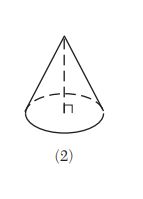1. Which object is formed when right triangle shown below is rotated around leg
?
(1) a pyramid with a square base
(2) an isosceles triangle
(3) a right triangle
(4) a cone
2. The vertices of have coordinates
,
, and
. Under which transformation is the image
not congruent to
?
(1) a translation of two units to the right and two units down
(2) a counterclockwise rotation of degrees around the origin
(3) a reflection over the
(4) a dilation with a scale factor of and centered at the origin
3. The center of circle has coordinates (
). If circle
passes through
, what is the length of its diameter?
(1)
(2)
(3)
(4)
4. In the diagram below, congruent figures 1, 2, and 3 are drawn.
Which sequence of transformations maps figure 1 onto figure 2 and then figure 2 onto figure 3?
(1) a reflection followed by a translation
(2) a rotation followed by a translation
(3) a translation followed by a reflection
(4) a translation followed by a rotation
5. As shown in the diagram below, the angle of elevation from a point on the ground to the top of the tree is .
If the point is 20 feet from the base of the tree, what is the height of the tree, to the nearest tenth of a foot?
(1)
(2)
(3)
(4)
6. Which figure can have the same cross section as a sphere?



7. A shipping container is in the shape of a right rectangular prism with a length of feet, a width of
feet, and a height of
feet. The container is completely filled with contents that weigh, on average,
pound per cubic foot.
What is the weight, in pounds, of the contents in the container?
(1)
(2)
(3)
(4)
8. In the diagram of circle shown below, chords
and
intersect at
, and chords
and
are drawn.
Which statement is not always true?
(1)
(2)
(3)
(4)
9. Which equation represents a line that is perpendicular to the line represented by ?
(1)
(2)
(3)
(4)
10. Which regular polygon has a minimum rotation of to carry the polygon onto itself?
(1) octagon
(2) decagon
(3) hexagon
(4) pentagon
11. In the diagram of below,
, and
.
What is the length of , to the nearest tenth?
(1)
(2)
(3)
(4)
12. In scalene triangle shown in the diagram below,
.
Which equation is always true?
(1)
(2)
(3)
(4)
13. Quadrilateral has diagonals
and
. Which information is not sufficient to prove
is a parallelogram?
(1) and
bisect each other
(2) and
(3) and
(4) and
14. The equation of a circle is . What are the coordinates of the center and the length of the radius of the circle?
(1) center () and radius
(2) center () and radius
(3) center () and radius
(4) center () and radius
15. Triangles and
are drawn below.
If and
, which statement is true?
(1)
(2)
(3)
(4)
15. If is dilated by a scale factor of
, which statement is true of the image
?
(1)
(2)
(3)
(4)
17. Steve drew line segments and
as shown in the diagram below. Scalene
is formed.
Which statement will allow Steve to prove ?
(1)
(2)
(3)
(4)
18. In the diagram below, is the image of
after a dilation of scale factor
with center
.
Which ratio is equal to the scale factor of the dilation?
(1)
(2)
(3)
(4)
19. A gallon of paint will cover approximately square feet. An artist wants to paint all the outside surfaces of a cube measuring
feet on each edge. What is the least number of gallons of paint he must buy to paint the cube?
(1)
(2)
(3)
(4)
20. In circle shown below, diameter
is perpendicular to
at point
, and chords
,
,
, and
are drawn.
Which statement is not always true?
(1)
(2)
(3)
(4)
21. In the diagram below, .
If ,
,
, and the perimeter of
is
, what is the perimeter of
?
(1)
(2)
(3)
(4)
22. The line is transformed by a dilation centered at the origin. Which linear equation could be its image?
(1)
(2)
(3)
(4)
23. A circle with a radius of was divided into
congruent sectors. The sectors were then rearranged, as shown in the diagram below.
To the nearest integer, the value of is
(1)
(2)
(3)
(4)
24. Which statement is sufficient evidence that is congruent to
?
(1) and
(2)
(3) There is a sequence of rigid motions that maps onto
,
onto
, and
onto
(4) There is a sequence of rigid motions that maps point onto point
,
onto
, and
onto
.















